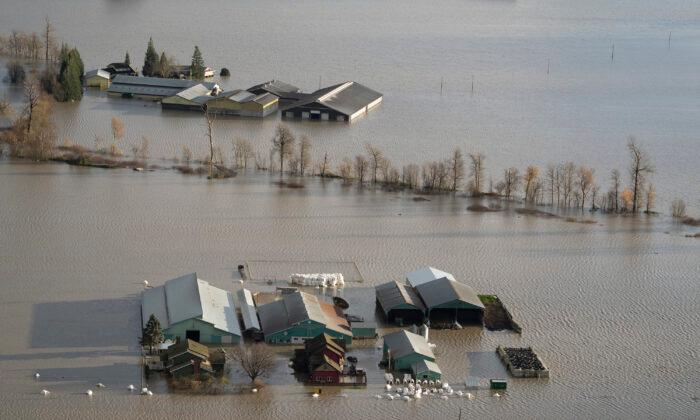A federal government report suggests that homeowners who experience flooding but had declined to buy flood insurance should not receive aid from its program established to help the provinces and territories (PTs) respond to large-scale natural disasters.
“Some PTs are moving toward refusing claims when someone is uninsured but flood insurance is available,” said the joint audit and evaluation of the Disaster Financial Assistance Arrangements Program (DFAA), the federal program administered by Public Safety Canada.
“It has been suggested that the federal government could encourage all PTs to adopt the strategy of refusing DFA [disaster financial assistance] payments to households that do not avail themselves of flood insurance,” the report added.
“If affordable flood insurance can be made available across Canada, the DFAA would not be needed for private property which would marginally reduce DFAA costs.”
The audit and evaluation report, which covers the fiscal periods from 2016–17 to 2020–21, states that residential loss only accounts for 15 percent of the federal program’s flood relief costs.
“This would still leave the federal government responsible for public sector assets which are the largest draw on DFAA funds,” the report said.
That largest portion of flood recovery costs goes to repairing and rebuilding damaged roads, bridges, utilities, and other public infrastructure.
Last-Resort Program, Not ‘Insurance’ Plan
Private home insurance covering overland flooding started becoming available in some parts of Canada in 2015. Historically, 80 percent of events assisted by federal disaster funding have been flood-related. Flood insurance is now available across the country except in most areas with a high-risk of flooding, leaving government financial aid the only option for those properties.
Starting in 1996, according to the report, Canada has experienced at least one major disaster per year, such as the 1996 flash floods in Quebec’s Saguenay region, the 2013 Calgary flood, the 2016 Alberta wildfires in Fort McMurray, and the 2021 extreme weather events in B.C., which included a heat dome, flooding, wildfires, and landslides.
Since the DFAA program began in 1970, the federal government has contributed more than $6 billion in post-disaster assistance to help with restoring infrastructure and personal property. More than half of this spending has occurred in the last decade.
The DFAA program has a cost-sharing formula calculated between the federal and PT governments. PTs have up to six months following the end of a natural disaster to request financial aid.
The auditors conducted 30 interviews with PT representatives and stakeholders from various groups involved in the DFAA program. They reviewed financial data, media reports, and academic research and noted in the report that while the program was created as a last resort, it is instead being used as an “insurance” plan.
Flood Mapping Outdated
“The DFAA was designed to be a reactive program that provides financial assistance in the years following a disaster. It was noted that the DFAA was created as a last resort program although it is not being utilized as such today. It was not designed to be an ‘insurance’ program that covers all disaster-related costs,” said the report.
“A number of factors are contributing to the rise of program cost, including: extreme weather conditions due to climate change, demographic growth, the state and location of private dwellings and public infrastructure, the market availability of insurance against various disasters, and the parameters of the DFAA itself.”
The report also said there has been no “consistent progress on flood mapping, PT emergency plans and critical infrastructure protections.” It said many flood maps are 20 to 25 years out of date, which may result in underestimating the risk of floods.
In addition, “Some stakeholders feel that PTs should have accountability for response, recovery and mitigation and that the DFAA ‘should be there for the incremental costs above and beyond what the PTs could reasonably be expected to pay,’” the report said.
More than half of the PTs indicated that the funding provided through the DFAA was important.
“Stakeholders made it clear that provincial and territorial budgets are not always sufficient and they can’t always carry the burden of a large-scale natural disaster,” the report said, adding that one stakeholder said “it is reasonable that the federal government provides a backstop.”
Stakeholders also said it is important for the federal government to acknowledge that capacity varies across PTs. For example, while one jurisdiction may have a robust emergency management office, another may not have an emergency management program in place, said the report, and this can impact disaster response and recovery.
Proposal to Mandate Insurance
According to Blacklock’s Reporter, a Jan. 13 report by the Council of Canadian Academies (CCA) suggested that Parliament create a national flood insurance program with mandated coverage for property owners at risk.
“Canada is an outlier among many advanced economies offering some form of nationalized flood insurance,” said the report titled “Building a Resilient Canada: The Expert Panel on Disaster Resilience in a Changing Climate.”
The CCA report was commissioned by the Department of Emergency Preparedness. It questioned payment of federal disaster relief to homeowners who live on flood plains but cannot or will not pay for private insurance.“Individuals who have reason to expect relief may thus choose to assume additional risk,” said the CCA report. It noted that mortgage lenders require some form of home insurance.
“In the panel’s view adjusting these requirements to ensure adequate protections from climate-related hazards is increasingly warranted in the face of mounting disaster risks,” the CCA report said.





